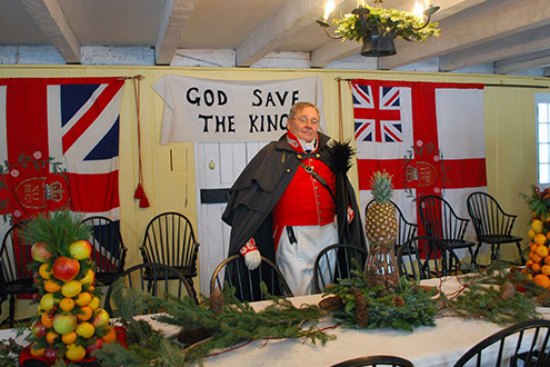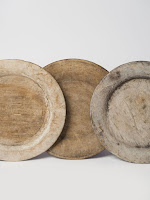Celebrations - Food - Decorations
While celebrations at Fort Amanda in 1813 may not have been as elaborate as those described below, an inventory in June of that year showed 3,657 gallons of whiskey was stored at Fort Amanda and my hunch is Captain William Ramsey ordered some of it distributed to his company from Preble County to celebrate the occasion.
"Tomorrow being Christmas Day it will be observed by the Troops in Garrison as a Sunday in every respect, and the civil artificers and Labourers in the Royal Engineers Department will be allowed a holiday from two in the afternoon on condition of their taking no time for dinner."
This "Scrooge" sounding order is contrasted by the Christmas preparations across the Atlantic in Gibraltar in 1806. At that station, the soldiers received advanced pay for three meals "for the purpose of providing a Good dinner for the different messes on Christmas Day. A drummer and psalm singers were selected from the garrison's regiments and, after practicing for a couple of weeks together, performed religious airs for the assembled church masses on Christmas Day.

Note: The Sutler contracted with the army to provide soldiers with personal iterms. Today it's called the "PX." (post exchange).
The soldier's food fare on Christmas day depended on where he was stationed. One soldier of the 40th Regiment in 1807 noted going ashore at Cork, Ireland to purchase "raisins, flour, fat and beer, and so being enabled to enjoy ourselves very comfortably." Naturally, if a soldier was engaged in active field service, it was difficult to celebrate Christmas. In 1813, John Cooper of the 7th Royal Fusiliers recounted the following while serving in the Peninsular War:
"Here for the first time in the Peninsula we kept Christmas. Every man contributed some money, meat or wine. A sheep or two were bought and killed. Pies and puddings were baked, etc. Plates, knives and forks, were not plentiful, yet we managed to diminish the stock of eatables in quick time. For desert we had plenty of apples; and for a finish, two or three bandsmen played merry tunes, while many warmed their toes by dancing jigs and reels."
A soldier room the 68th Regiment felt a little luckier about having a simple Christmas meal the previous year: "...we killed a young kid for our Christmas dinner, and we had what we considered a delightful repast, but nothing to be compared to what some of the poorest." peasants have in England." Christmas was also modestly celebrated by the soldier's family in the Peninsula. One 43rd Light Infantry officer in 1813 recounted:
"Just before dark while passing a corporal's picquet, an officer and myself stood for a few minutes, to contemplate a poor woman, who had brought her little pudding and her child from her distant quarters, to partake of [Christmas] with her husband, but the side of a small fire kindled under a tree.."
Because the British soldiers in Canada were lodged in comparatively comfortable quarters in the winter it is likely they fared better at Christmas time than their comrades serving in the Peninsular War. For example, purchases could be made a local stores to improve the soldier's lot at Christmas. For example one Royal Artilleryman purchased all spice on December 24th in Amherstburg, Upper Canada obviously for festive beverages for he and his comrades at the fort there.

Officer's Mess
The activities of British officers significantly contrasted those of their soldiers. In the Peninsula, one lieutenant noted dinner of "soup, salt fish, roast beef, boiled beef, mutton, vegetables and a remove of turkey, fowls, ham, and tongues - afterwards pastry." To wash this meal down, alcoholic beverages flowed freely for the Regency officer. For the mess of the Royal Artillery in Spain "the empty champagne bottles met in the centre of a long table forming an uninterrupted line of communication between the President and Vice-President." Similar scenes would have been found in the messes of regiments stationed in North America. One guest to the mess of the 41st Regiment expressed a fear that he should be made tipsy adding "'tis the fate of all Strangers, I hear; What think you? I think that when "I've got my quantity I shall walk away. We both realized our expectations. When I found myself on the point of trespassing against sobriety, I walked off, my friend stayed to finish the Campaign; or, without metaphor, the Champagne."
If not with their messes officers were often invited to the homes of local citizens. This was the case for Lieutenant John LeCouteur of the 104th while stationed in Kingston, Upper Canada. "That day, for amusement LeCouteur had fun with an old Christmas custom of the "First Footing", which determined the fortunes of the family in the coming year by the first visitor on Christmas day. A good year was expected if a handsome man visited bearing coal or salt; whilst a poor old woman arriving at your door was considered a bad omen. After arriving at the Christmas party the young LeCouteur set his plan into motion: After tea well over and arrangements were making for forfeits or some amusement to be fixed upon, I slipped out with Miss Ph__s, an ally who lent me one of Her Mother's dresses. In a short time I was fully equipped, slipped out of the back door, knocked at the front door, and requested to speak to the kind Old lady as a decayed Gentlewoman requiring aid. Miss Ph. was of course sent out to hear my story and thought it would be better the poor Lady should tell her own story to the whole party who might become interested in her welfare. This was reported and the decayed Lady told her piteous tale, loss of Husband, children, fortune. The old Lay herself was completely won and a large sum was preparing for her relief but a certain occasional twinkling in the unfortunate Lady's eye led one or two of the fair sparklers [to] suspect the truth - a whisper went about and screams of laughter following, the poor Lady had to cut and run."
One of the most significant Christmas parties during the War of 1812 occurred thousands of miles away from North America. In Ghent, Belgium, after signing the peace treaty ending the War of 1812 the previous day, the British and American representatives sat down on December 25, 1814 to a Christmas dinner of beef and plum pudding brought especially from England. Toasts were drunk to the health of King George and President Madison and the orchestra played "God Save the King" and "Yankee Doodle."

A satire showing the Christmas dinner of roast beef, plum pudding, and beer at the time war was declared on France, 1803
Holiday decorations put up by British officers and soldiers would have appeared Spartan by today's standards. The English soldier would likely have continued the ancient custom of "decking the halls" with greenery. Substituting for holly one new English settler to Canada in the 1820s noted bringing in "a wreath of boxleaved trailing wintergreen (which with its scarlet berries reminded me of the varnished holly with which we were wont to garnish the house at home), and hanging it over the mantel piece, and above the pictures of my host's parlor, in honor of [Christmas] day." It is possible English officers would have done likewise.
 Halls decked with holly and mistletoe in England. Note the ladies wearing holly in their hair.
Halls decked with holly and mistletoe in England. Note the ladies wearing holly in their hair. The German soldiers brought the Christmas tree to Canada. The commander of Hessian troops, Baron Von Riedesel, was first to introduce it in Sorel, Quebec in 1781. It is likely the German troops of 7th Battalion 60th, De Meuron's, and De Watteville's Regiments would have carried on this tradition during the War of 1812. Indeed in the middle of the Peninsular war, an officer of the King's German Legion decorated a lemon tree with lights and oranges to serve as his Christmas tree. It would be another 40 years before the Christmas tree would become common place in English society.

While there are some accounts of Christmas celebrations in the army as noted above, the majority of soldiers' diaries and accounts of the time are quite silent on the matter. It would not be until the 1840s and 1850s that the celebration of Christmas by British soldiers became a major affair with decoration committees and significant fanfare. One dilemma encountered by historic sites portraying life during the War of 1812 is that the public expects Christmas decorations and festivities that did not, in fact, take place until Victorian times. One possible solution would be to decorate the site as it would have appeared during a wintertime ball. This would allow staff at historic sites to simultaneously present two themes: Christmas in 1812, and leisure of the British Army during the winter months. The resulting decorations would surely kindle the festive spirit of any visitor, all the while avoiding an unfortunate misrepresentation of Christmas during the War of 1812. Lastly Christmas carolling by the poor was quite common in this time period. If that doesn't entertain visitors, brewing up some Christmas ale could lift some spirits.












































